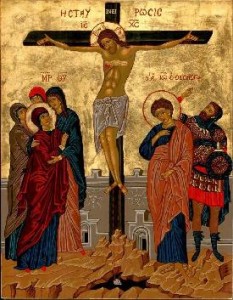 The past few years I have been on a mission to write, preach, and teach the women of Holy Week back into our Holy Week liturgies, practices, and Scriptures. In this post we’ll learn about the women at the cross and tomb in Mark.
The past few years I have been on a mission to write, preach, and teach the women of Holy Week back into our Holy Week liturgies, practices, and Scriptures. In this post we’ll learn about the women at the cross and tomb in Mark.
Women were watching from a distance. Among them were Mary Magdalene, Mary the mother of James the younger and of Joses, and Salome. They had followed him and ministered to him when he was in Galilee. Many other women who had come up with him to Jerusalem were also there. That evening, because it was the Preparation Day (that is, the day before the Sabbath), Joseph of Arimathea came. He was a prominent council member who was also looking forward to the reign of Godde. He dared to go to Pilate and asked for Jesus’ body. Pilate was amazed that he might already be dead. He called the centurion and asked him whether Jesus had been dead long. When he confirmed it with the centurion, he gave the body to Joseph. He bought a linen cloth, took down the body, wrapped it in the linen cloth, and laid it in a tomb that had been cut from rock. He rolled a stone to the door of the tomb. Mary Magdalene and Joses’ mother Mary saw where he was laid (Mark 15:40-47, New Testament: Divine Feminine Version [DFV]).
Mark’s Passion Narrative began in chapter 14 with the female prophet who anointed Jesus as king and prepared him for his burial. Mark’s Passion ends with Mary Magdalene, Mary the mother of James and Joses, Salome, and “many other women who had come up with him to Jerusalem” bearing witness at the cross, and the two Marys holding vigil in front of the tomb. Jesus’ betrayal, arrest, denial, trial, and crucifixion are held in the embrace of the women who “had followed him and ministered to him when he was in Galilee” and followed him to Jerusalem.
In Mark those who follow Jesus are disciples. Minister comes from the Greek word group from diakonos, which means to serve (and the word we get our word deacon from). Originally meaning “table service,” in the New Testament it becomes a specialized term which means ministers of the Word and Eucharist. In Mark the only other times minister is used are when the angels minister to Jesus after his temptation, when Peter’s mother-in-law ministers to Jesus and the disciples after Jesus heals her, and when Jesus says “the Son of Woman came not to be served but to serve, and to give his life to liberate many” in Mark 10 :45 [DFV] (which means the only man serve or minister is used for in The Gospel of Mark is Jesus. The other times the words are used refer to angels or women). Elizabeth Struthers Malbon notes “Not only does Jesus take up women’s work, but women take up Jesus’ work. Women, from near the bottom of the hierarchy of power, have served and remained faithful followers to the end–although even they are ‘looking on from afar’….It is striking that Mark chooses to emphasize the presence of women followers in the absence of the male disciples at the crucial moment of Jesus’ death. Those with power can learn from those with less power” (“Gospel of Mark,” Women’s Bible Commentary, 491).
Mary Magdalene, Mary, Salome, and the other women continued to faithfully minister to Jesus until the end. The did not run away, they did not hide. Even if it was at a distance, they stayed with Jesus. They bore witness to his death, and they made sure he did not die alone. Mary Magdalene and Mary watched Joseph of Arimathea bury Jesus then remained at the tomb holding vigil. On Sunday morning they would be the first ones back at the tomb to finish anointing Jesus’ body for burial. We come full circle: at the beginning of the Passion Narrative the female prophet anointed Jesus to prepare him for the days ahead, and now Mary Magdalene and the other women who followed Jesus from Nazareth (and the prophet could have been one of their number) now come to finish anointing Jesus’ body.
Their tenacity, perseverance, and faithfulness is rewarded: they are the first to hear of the resurrection and see the risen Jesus. As they bore witness to the death and burial of Jesus, they now bear witness to the resurrection of Christ and are commissioned to tell the rest of the disciples that God has raised Jesus from the dead.
Pingback: Shawna R. B. Atteberry » Want to Know More About Your Spiritual Foremothers? DO NOT watch Lifetime’s Women of the Bible